New Vrindaban Hosts Its Second Deity Worship Seminar
Sunday morning, Dec. 7, was the last day of the Deity Worship Seminars here in New Vrindaban. This was the second Deity Worship Seminar taught by His Grace Jayananda prabhu in New Vrindaban. Jayananda explained, “We did a very short seminar last year, but we wanted to increase the depth of this seminar. So this weekend we offered a full 20 hours of study. It was very detailed but it is going well.” ISKCON Deity Worship Minister for North America Jayananda is a disciple of Bhakti-Tirtha Swami, and was trained in Deity Worship at the Mayapur Academy in West Bengal.
The 26 participants, from such places as D.C. and Potomac, MD, and including New Vrindaban’s pujaris, learned about how the Lord is present in His deity form, as well as the goal and proper mood of deity worship, dressing, mantras, mudras and festival abhisheks.
One pujari gentleman from the Washington, D.C. area said, “These workshops are reinforcing many things I’ve already learned in deity worship, plus I’m learning so many new things. Plus, I wouldn’t miss an opportunity to visit New Vrindaban! It’s beautiful here!”
One pujari woman told us, “Jayananda prabhu is very approachable, and easy to understand. He makes these seminars very clear to everyone. I appreciate that. We can even ask him about any Deity issues we have, and he seems happy to help.”
Srila Prabhupada’s vision for New Vrindaban included spiritual education, focused on loving Krsna, as one of the 5 main goals for this community. The association of the devotees, focused around important Krsna conscious themes, such as proper deity worship, is the life of a devotee. New Vrindaban is looking forward to hosting many more such programs in the future.
Discussions at the New Vrindaban Community Dialog – Fall Board Meetings
New Vrindaban Fall Board Meetings 2014:
Community Dialogue Discusses Palace Wall and Succession
By Madhava Smullen
The recent Fall Board Meetings at New Vrindaban included a community dialogue on November 1st that brought up some lively discussion on pressing issues.
Community President Jaya Krsna Das and Palace Restoration Manager Gopisa Das first presented a proposal to renovate the boundary wall around the grounds of Prabhupada’s Palace.
The wall is falling apart and needs attention, Jaya Krsna said, as it is the first thing visitors see, and first impressions are important. He also pointed out that according to Gus Kayafas, the Wheeling architect who specializes in the preservation of historic buildings and is working with Gopisa on the project, the rustic appearance of the wall does not match the expectation created by the Palace’s opulent reputation.
Kayafas Architects’ proposal suggests that “the entire existing top course of block, rubble and decorative elements be removed and a new integral bond beam created. A precast concrete wall cap will provide the visual continuity. A sense of rhythm will be reinforced with a more refined stone pilaster with decorative stone inlay [of black granite]. The original colors of black and salmon will be utilized.”
This restoration plan would prevent the previous deterioration that had occurred due to water intrusion and poor construction techniques from happening again.
Sitting in a circle facing each other, board and community members discussed the proposal. Several devotees felt that the wall blocked the Palace from view, and suggested removing it completely. Others suggested putting up a wrought iron fence that the Palace would be visible through instead.
Jaya Krsna concluded the session by saying that the Prabhupada’s Palace Restoration Committee appreciated hearing from everyone, and would take the feedback into consideration during their decision-making process.
For the Community Dialogue’s second item, the New Vrindaban Community Advocacy Sanga, represented by Nityodita Das, brought up one of its main concerns, the need for succession in an ageing community.
The issue generated a lot of interest and opinions, with many devotees contributing to the lively discussion on how to attract younger devotees to live in New Vrindaban, and help them become situated as long-term residents within the broader community.
Several people brought up the need to plan a smooth transition from the student ashram to the householder ashram, develop a strong householder community, and have good income sources, a sense of community, and assistance with housing and land acquisition.
Board member Chaitanya Mangala suggested that concerns about acquiring land within the community could be eased by broadening the vision of what constitutes New Vrindaban to Srila Prabhupada’s grand request to “convert West Virginia into New Vrindaban.”
Jaya Krsna talked about how ISKCON New Vrindaban is already meeting some of the needs that were raised – the management has recently helped several devotees to move to the community and acquire land; there is a dedicated real estate manager to help devotees with land acquisition; and there are already about half a dozen independent companies within the geographic boundaries of New Vrindaban that provide employment opportunities.
What’s more, there are future plans for a building at Bahulaban where artisans and craftspeople could set up small businesses, as well as an ongoing discussion about how to attract more business owners to the area in general.
Jaya Krsna also pointed out that while ISKCON New Vrindaban management is doing what it can to help, the long-standing expectations that it be responsible for all the needs of the broader community are unrealistic and are a standard no other ISKCON organization is held to.
Chaitanya Mangala agreed, calling for a paradigm shift that would see a strong and vibrant householder community with a healthy temple environment at its center, something Jaya Krsna presented as a model earlier in the board meetings.
In the end, while there was no clear solution to an ongoing and complicated topic, the dialogue concluded with a collective resolve to continue exploring ways to attract young devotees to move to New Vrindaban, and to create an atmosphere that has them wanting to stay.
New Vrindaban Community Parikrama Showcases Exciting Developments
New Vrindaban Fall Board Meetings 2014:
Community Parikrama Showcases Exciting Developments
By Madhava Smullen
On November 2nd, after spending the previous day hearing presentations on New Vrindaban’s many departments, board and community members wrapped up this fall’s meetings by seeing some of the latest developments for themselves in an enlivening community parikrama.
At 10:00am, around twenty-five people stepped out into a crisp but brilliantly blue and sunny morning and made their way first to the old barn at Bahulaban, which had fallen into a severely dilapidated condition over thirty years but is now being rebuilt as a new ox training center.
Renovation project manager Vyasasana Das spoke about his work on the barn, which has been given a brand new wood frame over its original core structure. He indicated the spaces on the first floor where there will be hay storage and corrals for oxen, and on the second floor where there will be living quarters for people working with the ox program.
Daivata Das, who worked with oxen when Prabhupada was physically present and is back to carry out the same service, showed everyone the training area at the back of the barn, and spoke about how he hopes to have the young oxen pulling a cart next year. He was clearly brimming with enthusiasm at getting to serve the community in this way again.
Meanwhile New Vrindaban pioneers Madhava Gosh and Advaita Das told stories about how devotees lived in the barn with their families in the early days, and how Advaita’s son was born there.
Madhava Gosh and his wife Vidya, who received an appreciation plaque to take home the previous day, were then presented with another public plaque which will remain permanently affixed to the new ox barn. “In recognition of more than four decades of service rendered to the cows and gardens of New Vrindaban by Madhava Gosh Dasa and Vidya Dasi,” it reads, “The Board of Directors of Eco-Vrindaban hereby renames this building the Madhava Gosh-alla.”
After everyone had a good chuckle at its pun-tastic new name, the ox program’s spiritual advisor Varshana Swami reminded them that the barn also had great spiritual significance. “It’s the last place built by devotees that Srila Prabhupada visited in Bahulaban,” he said. “And now, it’s getting a second life.”
Next, the tour moved on to the hilltop Radha Gopinath Mandir. Still under construction, it’s set to be a small replica of the original temple in Vrindavan, India. Varshana Swami, who is overseeing the project, pointed out the Radha Gopinath Deities residing in an elegant gazebo nearby, and said that They would move into Their temple once it is completed.
He then explained the history of the project, outlining Srila Prabhupada’s instructions to build not only seven replicas of Vrindavan’s seven main temples, but also replicas of its sacred lakes. He showed the group two of these replica lakes, Radha Kunda and Lalita Kunda, and spoke about the pastimes Krishna performed at them, while community president Jaya Krishna Das cheerfully sprinkled everyone with their sacred waters.
The tour also inspected a computer-generated image of the Radha-Gopinath Mandir, with Raghunath Das Goswami’s bhajan kutir and Radha-Kunda next to it.
“Please offer your blessings and prayers that Srila Prabhupada’s vision will unfold more and more,” Varshana Swami requested the assembled devotees.
From Radha-Gopinath Mandir, the parikrama went on to the Garden of Seven Gates. Garden manager Kacey Orr showed everyone the new greenhouse for in-ground planting, where greens will continue to be harvested until February and will last the Temple through much of winter.
She also took the tour through the recently renovated flower greenhouse, which was dormant but will see an astonishing twenty to thirty thousand flowers grown there throughout the 2015 growing season.
Walking through the open fields in the Garden of Seven Gates, Kacey talked about the crops grown there, including tomatoes, peppers, Chinese cabbage, green beans, pumpkins, watermelon, squash, ten-foot-high sunflowers, and marigolds, which were still growing in a golden carpet across the ground.
“Every time we pick, there are fifty gallons of marigolds,” Kacey said, before pointing out the area where a brand new rose garden, exclusively for the Deities, will be grown next year.
Kacey’s last stop was the smaller Teaching Garden, a cosy haven for herbs and flowers encircled by a newly-built honey-colored fence and gates. A regular site for guest tours, its centerpiece is an attractive wooden pergola where devotees can chant or make garlands, and guests can relax and soak up the peaceful environment.
“Next spring we will be taking it up to show-level, and putting signs in every bed so that guests know what they’re looking at,” said Kacey.
Finally, the tour visited the community’s milking barn where nine Brown Swiss cows are milked, passing through the new swing and large decorative flower planters at the entrance. Inside, cowherds Ananda Vidya and his wife Lalita Gopi pointed out the new extension to the feeding aisle, and the new enclosed loafing area for the cows to relax in a dry, hay-covered space.
The weekend ended with a beautiful pushpanjali ceremony honoring Vaishnava acharya Gaura Kishora Das Babaji on his disappearance day. Afterwards, as they tucked into an Ekadasi Sunday Feast, all the devotees excitedly discussed everything they had seen and heard, inspired to continue their service with renewed energy and support New Vrindaban in its ongoing growth.
Prabhupada’s Vision for New Vrindaban: Working Oxen
“You should also use the bulls by engaging them in tilling the ground. People may call this the primitive way but it is very practical for engaging the bulls – have them work in cart loading, transporting, etc.” – Srila Prabhupada, January 1974.
Click here to read the rest of the letter at the Brijabasi Spirit website.
New Vrindaban Hosts Special Deity Worship Seminar
DEITY WORSHIP SEMINAR
Presented by His Grace Jayananda das
www.deityworship.com www.mayapuracademy.org
Details are below the schedule.
Schedule
Fri. Dec. 5, 2014
Seminar 11:00 am-1:30 pm
Lunch 1:30 pm
Seminars 3:00 pm- 7:00 pm
Sat. Dec. 6, 2014
Special Early Class 8:00 am -9:00 am
Seminar 10:00 am – 1:30 pm
Seminars 3:00 pm- 7:00 pm
Sun. Dec. 7, 2014
Special Early Class 8:00 am-9:00 am
Seminars 10- 1:30 pm
END OF SEMINARS…See seminar details below.
Friday, Dec. 5th
- 11-1:30
- Introduction
- History and progress of IDWM
- Role & function IDWM
- ISKCON deity worship strengths/challenges
- Why perform deity worship?
- The Lord is present in His deity form
- 3-7
- Definition and goal of arcana
- Authenticity of deity worship
- Pancaratrika & Bhagavata vidhi
- Qualifications for arcana
- Position of the spiritual master
- Variations in arcana procedures and standards of worship
- Festivals observed (time permitting)
- Saturday, Dec. 6th
- 8-9
- Mood of worship
- Values, attitudes, and behavior of a pujari
- 10-1:30
- Deity dressing
- Purity
- Mantras and mudras
- 3-7
- Acamana: demonstration & discussion
- Waking & Resting: demonstration & discussion
- Bhoga offering: demonstration & discussion
- Arati: demonstration & discussion
- Sunday, Dec. 7th
- 8-9
- 16 items of worship overview
- 10-1:30
- Sodasopacara puja demonstration (Standard GN procedure)
- Festival abhiseka
ECO-Vrindaban Offers Appreciation Plaque to Devotees for 40 Years of Service
New Vrindaban Fall Board Meetings 2014:
Madhava Gosh Das and Vidya Dasi Receive Appreciation Plaques for 40 Years of Service
By Madhava Smullen
During the ISKCON New Vrindaban and Eco-Vrindaban Fall Board Meetings on the first weekend of November this year, long-time residents Madhava Gosh Das and his wife Vidya Dasi were officially honored for their more than forty years of service to the community’s cows and gardens.
The event took place in the community hall on November 1st after the department head reports. Madhava Gosh, who has been suffering in recent times from a serious decline in health, sat on a sofa at one end with Vidya. Board and community members alike arranged their chairs in a circle facing them to create a more intimate atmosphere.
ECO-V chairman Navin Shyam Das introduced the guests of honor, but acknowledged that there was someone who took care of the cows and gardens way back, “before Madhava Gosh was around.” He then read a detailed and glowing report of food production in the New Vrindaban gardens published in the second ever issue of Brijabasi Spirit magazine in 1974.
“When I read this, I thought, ‘We’re honoring Madhava Gosh, but maybe we should find this Bhakta Mark fellow and honor him!” Navin joked, revealing them to be one and the same. He added, “Then I realized behind both of them was another even greater personality – Vidya Dasi!”
Navin spoke a little about their history. Hailing from a family that has farmed for generations, Madhava Gosh moved to New Vrindaban in 1974 soon after joining ISKCON. He was initiated during Srila Prabhupada’s visit that same year, and went on to serve in New Vrindaban’s garden and plough departments throughout the 1970s.
He continued to put energy into cow protection and food production even in the ‘80s and ‘90s when the community’s emphasis on them decreased. In the early 2000s, he started his own blog, “View From a New Vrindaban Ridge,” providing positive reports on the community’s efforts amidst a negative worldwide perception, and in 2006, he revived the Brijabasi Spirit online.
He has been an ECO-V board member since its launch and has been a major instigator behind recent efforts such as increasing use of New Vrindaban’s own protected dairy, planting fruit and nut trees, increasing ox engagement, establishing a trust for the future care of cows, and planning an eco-village. He also personally enlisted Kacey Orr, ECO-V’s dynamic new garden manager.
Meanwhile Vidya Dasi came to New Vrindaban a year earlier than her husband, in 1973, and has steadily played a key role in the community’s gardens ever since, and in particular its flower gardens — she was one of the early organizers of the Rose Gardens at Prabhupada’s Palace.
In the early days, as one of the first women in the community to have children, she was active in running a nursery program, and now proudly cherishes five grown-up children and three grandchildren. Today, she continues to be a major force behind the flower gardens and festivals like the new Pushpa Abhisheka. She and Madhava Gosh have been married for an exemplary forty years.
After citing their achievements, Navin Shyam presented Madhava Gosh and Vidya with an engraved wooden plaque commemorating their service, to uproarious applause.
Inscribed with the new ECO-V logo, the plaque reads, “The Board of Directors of Eco-Vrindaban hereby presents this plaque to Madhava Gosh Das and Vidya Dasi in recognition of their more than four decades of service to the cows and gardens of New Vrindaban.”
Speaking to the crowd, Vidya said, “I feel really honored and humbled to get this, and I’m going to really appreciate it. I wish my children could have been here, but they’re spread out all over the country. They do know about it though.”
With heartfelt sincerity, Madhava Gosh said, “There’s so many that really deserve a plaque. I almost feel that this is unwarranted. I don’t know if I was such a great devotee over all those years… But we tried. We were just trying to do the best we could. Looking back, there’s a bit of lamentation, ‘You could have tried harder. You could have done more.’ I’ll accept this, but I don’t know if I really deserve it.”
“This is not so important for me — I could care less about this kind of stuff,” Gosh concluded, holding up the plaque. “So this is for my grandchildren. It’s something that they can remember me by.”
New Vrindaban’s Transcendental Throwback Thursday – 12/04/2014
We share two photos of the same event; one featuring women and the other featuring men. Between them there 11 people who can be identified.
This week’s challenge: How many people can you ID? What are they doing? When and where were these photos taken?
Bonus challenge: Can you name the person who appears in both photos (who’s not a Deity)?
What to do: Post your guesses on the “who, what, when, where & why” in the comment section at the New Vrindaban Facebook page.
Department Head Reports Invigorate the New Vrindaban Community
New Vrindaban Fall Board Meetings 2014:
Department Head Presentations Invigorate the Community
By Madhava Smullen
ISKCON New Vrindaban and Eco-Vrindaban’s second annual board meetings, held from November 1st to 2nd this year, shone a light on the rejuvenating rush of energy currently flowing through the New Vrindaban community and were invigorating for all the participants.
With the entire meeting open to all community members, there was a buzz of excitement as devotees bustled into the community hall at 10:00am to see what the first part of the meetings – a four-hour presentation of New Vrindaban’s 22 departments – would hold.
In his introduction, president Jaya Krishna Das reminded everyone of Srila Prabhupada’s vision for New Vrindaban as a sacred place known for cow protection, self-sufficiency, holy pilgrimage, spiritual education, and above all, loving Krishna. He said that the transformational process the community began in 2011 has now past the ‘survival’ phase and entered the phase of improvement, and spoke of the need to develop a strong and healthy relationship between the temple and the broader community.
Kicking off the presentations, Lilasuka Dasi from Communications spoke about sharing news on New Vrindaban’s website and Facebook page, the Palace of Gold Facebook, Brijbasi Spirit blog, and monthly physical newsletter “News From the Holy Dhama.” Next year she’ll continue to focus on internal communications while Vrindavan Das connects with the media.
The Deity Dept., led by Abhinanda Das, reported a more stable, punctual operation with a reliable team of pujaris and good team spirit. Visitors were inspired by the beautiful festivals including the new Pushpa Abhiseka. In 2015 the dept. will renovate the Deity kitchen and pujari rooms, build a new Tulasi Devi greenhouse, and raise worship standards by hosting the ISKCON Deity Worship Ministry’s pujari training seminar.
Prabhupada’s Palace of Gold, managed by Tripad Das, had a good tourism season with lots of prasadam and books distributed to visitors from Pittsburgh and beyond.
The Palace Rose Garden, run by Gopalasyapriya Dasi, has “gone green” and plans in 2015 to develop a “Srila Prabhupada Rose” for ISKCON’s 50th.
Palace Restoration manager Gopisa Das reported one chattra renovated; black granite being laid on the upper steps; a new fountain and benches at the lotus pond; a new drainage system; and an emergency connection to city water for the community. 2015 will see the upper steps completed, lower steps started, parking lot extended; and the railing up to the Palace renovated. There are also plans underway to renovate the Palace’s boundary wall.
In Construction and Maintenance, previously overseen by Gopisa and being led from November 2014 by new resident Bhakta Paul, the temple guest rooms were renovated; the parking lot elephant restored; attractive signs posted everywhere to direct guests; and all temple doors and windows are being replaced to keep in warmth. Next year Paul will renovate the swan boat house, build a new kids’ playground, and complete many other departments’ construction projects.
Next Jayarama Das spoke about Congregational Development, where nine congregation members were initiated, 3,000 japa beads and 5,000 books were distributed, and donations are up 25%. Jayarama takes guests on a guided pilgrimage of New Vrindaban, while Gaura Nataraja Das visits the local prison weekly and his online Gita classes are watched by 500. Next year, the dept. plans to start a kids’ Sunday School and increase Palace of Gold entrances by 20%.
Sankirtan, led by Bhakta Trevor, reported distributing books and holding congregational chanting of the Holy Name every week in Wheeling, Morgantown, and Pittsburgh. 2015 plans include attracting new devotees and distributing prasadam at West Liberty University.
Sukhavaha Dasi reported that new dept. Devotee Relations opened an office in the temple with regular hours for devotees to express concerns; ran a pilot course on empathic communication; and offered counseling and conflict resolution. Next year it will open a Holistic Community Center, offer a free course to help second-gen devotees heal, and develop various support groups.
Govinda’s Restaurant, run by Vasudeva Das, hosted many tourist groups and students, and dramatically increased use of New Vrindaban’s own organic vegetables and cows’ milk. In 2015 it plans to use no commercial milk, finish its new décor, install a book display, reach out more to tour groups, and introduce popular dishes like lasagna, pie, breads and salads.
Under Vasudeva’s son Gaura Bhakta, the Guest Lodge finished seven more room renovations and replaced furniture in the cabins. Next year, it will add four new rooms with attached bath; update the cabins; introduce a uniform with name tags; start promotions and discounts; and add a desk that provides newcomers with information about Krishna consciousness.
Vrindavan Das of Festivals talked about Festival of Inspiration’s successes and challenges, increased attendance for 24 Hour Kirtan and Festival of Colors, and the first-ever Pittsburgh FOC drawing 6,000 students. Next year, the highest profile speakers in ISKCON will be invited for FOI’s 15th anniversary; 7,000 are expected at the NV FOC; and the dept. will add a public Rathayatra festival, a New Year’s Retreat and a retreat with Bhakti Charu Swami.
Gopal’s Garden, the Homeschool co-op run by Ruci Dasi, reported its students learning computers, Deity worship, art, and poetry as well as standard subjects, and doing service and kirtan together. Ruci, who has been teaching at NV for over thirty years, is encouraged by the enthusiasm of the students and parents, and looks forward to having many more students.
Among other departments’ achievements, Tejomaya Das at Water and Waste Water installed a new well that doubles capacity for festivals; Vyapi Das at the Apartments upgraded three apartments and will hand over his service to Hrishikesh Das in 2015; Varshana Swami at Land Management completed the parking lot at Bahulaban and finished the Parikrama path around Lalita Kund; and the aptly-named Laxmi Honest in Accounting is improving relationships with the bank, streamlining bookkeeping processes and saving thousands as she does so.
Eco-Vrindaban’s department head presentations followed. In his introduction, chairman Navina Shyam Das outlined how the organization covers the cow protection and self-sufficiency elements of Srila Prabhupada’s vision. He showed its brand new logo, and reported how in the past year ECO-V had officially changed its name from GEETA, refined its mission statement and become an integrated auxiliary of ISKCON New Vrindaban. He also spoke about its search for a manager, and introduced Mukunda Das, who was visiting from Alachua and participating in the weekend’s activities, as a strong candidate.
Next, Ananda Vidya and his wife Lalita Gopi spoke about the Cow program, which cares for 41 cows with nine milking cows and five new male calves. The milking barn has been extended to include a ‘loafing area’; cows are receiving first-class medical care; and the temple is being supplied with milk, yoghurt, panir, and butter. Next year the dept. will use non-GMO feed for the cows; cultivate nicer grasses in the pasture; and start a program to reduce flies.
For Ox Care, Daivata Das, who worked with oxen in Srila Prabhupada’s time, showed photos of the lively young oxen Harichand and Amani working with a yoke, and said that he hopes to have them pulling a cart next year, and living in their rebuilt ox barn at Bahulaban.
Kacey Orr at the Gardens reported a fully-planted high tunnel and hothouse greenhouse; harvesting many varieties of vegetables; a much better relationship with the temple kitchen; a new pergola with seating in the Teaching Garden; and regular guest tours. In 2015, she wants to double vegetable production; sell produce to guests on the weekends; offer internship programs for local students; and open the Garden of Seven Gates’ new rose garden for the Deities.
All presentations were deeply inspiring and reflected the progress New Vrindaban has been making lately.
“Visitors have already been saying they feel the change,” said Jaya Krishna Das, citing the need for deeping relationships and a Brijbasi mood of community spirit and unity moving into the future.
Greeting from the New Vrindaban Gardens: Fall/Winter 2014
The fall season has come and gone quickly this year in the garden. Many projects were completed in the Teaching Garden and the Garden of Seven Gates. An early frost drove our attentions into our new high tunnel for winter greens and building a new rose garden to be planted in the spring.
Throughout the fall we harvested cabbage, spinach, lettuce, radishes, and assorted greens. The colorful hardy calendula flowers made it all the way into mid-November providing vivid yellow and orange flowers. A 25×50 foot high tunnel using only the sun for heat is now planted with close to 1000 plants: leaf lettuce, head lettuce, two varieties, or spinach, paper white narcissus and kohlrabi. The first week of December will be our first harvest from the high tunnel, just two weeks after our last out door harvest. The three terraces and both large fields in the Garden of Seven Gates have been cover cropped to enhance the soil, deter early spring weeds, and reduce soil erosion. The biggest plant job was removing all of the plants from the season and moving them into our compost pile. Within the garden is a very large compost pile that combines cow manure and all of the green garden waste. By next fall we will have enough compost to use throughout the garden.
A new rose garden and peaceful sitting area for visitors and community members is being constructed at the far end of the Garden of Seven Gates, just beyond the crest of the hill. As visitors enter the garden the top of wooden entrance arch, made from all reclaimed vines found outside the garden, can be seen over the cresting hill. In a few years this arch will be covered in white trailing roses. The garden was designed to look like it came a hundred years before the vegetable garden around it. Reclaimed large stones carved in the 1800’s were used to create the front fence and wishing well style planters. Flat stones reclaimed from the sounding areas are being used for a stone walkway that winds through the garden. Open rustic fencing on the sides of the garden were built from all reclaimed wood and vines found in the woods outside the garden. Finally, raised beds are being designed from old manure near the new ox barn. The new roses will be planted in early March. Just a few days ago we received a shipment of English Walnut trees to be added to our growing orchard. This coming week will be dedicated to getting the trees planted before the ground freezes and cages built around them to protect the trees from deer.
The Teaching Garden is getting many new improvements. The first was completed the last week of October, a beautiful new pergola. It will serve as a seating area, work benches for planting or garland making, and a trellis for vining flowers and bitter melons. Throughout the winter we will be rebuilding the interior of the tool shed to create space for volunteers, visitors, workspace, and storage. The exterior will also receive some attention with paint, seating, and storage. Next summer we hope to transform this area into a weekend farmers market.
Throughout the winter we will be planning and prepping for spring. By early February we will be seeding the earliest of spring vegetables. Such as English peas, kale, broccoli, cabbage, arugula, and early flowers. As the garden is resting for the winter I hope we can all take some time to plan and dream about our beautiful spring gardens.
Srila Prabhupada Envisions a “New” Vrindaban
Srila Prabhupada Envisions a “New” Vrindaban
Written by Madhava Smullen. Archival Research by Chaitanya Mangala.
“You have New York, New England, and so many ‘New’ duplicates of European countries in the USA, why not import New Vrindaban in your country?” –Srila Prabhupada, Letter, 3/17/68
In the spring of 2013, board members for ISKCON New Vrindaban and ECO-Vrindaban unanimously adopted a new community vision statement. It was called “Srila Prabhupada’s Vision for New Vrindaban.”
Its implementation as a renewed focus for the community might be new. But its roots go back long before Srila Prabhupada had even left India for the United States.
Back in 1956, while working alone in Delhi on his Back to Godhead magazine, Prabhupada had written a series of articles detailing his vision for a community where people would live a simple life based on the teachings of the Bhagavad-gita.
When he established ISKCON in New York in 1966, his seven purposes for the society included bringing members closer together “for the purpose of teaching a simpler and more natural way of life.”
As early as January 1968, he was issuing specific instructions about the community to his disciples: “The Ashram may be named as “ISKCON-Nagari or New Vrindaban.” And from May 1968 – the year when New Vrindaban was established — he issued a string of letters to his disciples describing exactly how he envisioned the community.
Through these, it’s clear that Prabhupada saw New Vrindaban as a sacred place known worldwide for five primary things: cow protection, simple living, holy pilgrimage, spiritual education, and above all, loving Krishna. And it’s these things that form the core of New Vrindaban’s vision statement today.
The first four are all inextricably connected to the last, loving Krishna. While teaching the importance of cow protection, for instance, Srila Prabhupada aligned New Vrindaban with the original transcendental village of Vrindavan, where Lord Krishna, His brother Balaram and Their friends would take Their cows to the pasturing grounds every morning.
“Krishna by His practical example taught us to give all protection to the cows and that should be the main business of New Vrindaban,” he wrote in a 1968 letter to Hayagriva.
Prabhupada taught the early residents of New Vrindaban to respect the cow and bull as their mother and father, as they could provide so many of the essentials of life. The bulls could till the ground, and be used for carting and transporting; while the cows could provide dung for fuel, and milk, butter, ghee and cheese for nourishment.
“The whole idea of New Vrindaban is that men who are living there should produce their own food, of which milk is the principal thing,” he wrote to Kirtanananda in July 1969.
Prabhupada envisioned New Vrindaban as a “self-governing village” that would set an example for the world and contain all the basic necessities residents needed: in one letter he explained how they could grow vegetables, fruit, wheat and other cereals, hand-weave cloth, and use an ox-powered mill to grind seeds into oil. Working to create this self-sufficiency, meanwhile, would keep devotees busy in the service of the Lord and ensure that they didn’t have to search for work outside.
This simple life wherein devotees had everything they needed, and weren’t distracted by trying to derive sense pleasure from modern amenities, was key to developing high thinking; or, in other words, Krishna consciousness, the true nature of the soul.
Adding further to the spiritual atmosphere of New Vrindaban were Prabhupada’s grand plans to physically recreate the original Vrindavan there, turning the community into a pilgrimage place. New Vrindaban is unique as the only farm community he envisioned in such a way.
“I have got ambition to construct there 7 temples as follows: 1. Radha Madan Mohan, 2. Radha Govinda, 3. Radha Gopinatha, 4. Radha Damodara, 5. Radha Raman, 6. Radha Gokulananda, 7. Radha Syamasundara,” he wrote to Hayagriva as early as 1968. He added in other letters, “The hilly portions may be named as Govardhana” and “If there are lakes, they can be renamed as Syamakunda and Radhakunda.”
Prabhupada hoped that these attractions and the Krishna conscious way of life would draw the public to visit. “I am sure this… attraction will make our neighbors friendly and surely they will come in number in future so that New Vrindaban will be ideal place for visiting from the neighboring provinces,” he wrote.
Adding to the appeal of New Vrindaban would be its spiritually-educated residents, who would be able to realize the first of Prabhupada’s seven purposes for ISKCON and “systematically propagate spiritual knowledge to society… in order to check the imbalance of values in life and to achieve real unity and peace in the world.”
Prabhupada specifically called for a “Rupanuga Vidyapitha” in New Vrindaban, a “school for educating brahmanas and Vaisnavas.”
He also recommended a school to teach Varnashrama, a traditional Vedic social structure of natural vocations and life stages, as well as a primary school where children could come from urban centers to learn reading, writing, mathematics, the basic sciences and Krsna consciousness.
All of this, of course, ultimately comes down once again to the essence of all of Srila Prabhupada’s directions for New Vrindaban: Loving Krishna.
“The cows, the trees, the cowherd men and gopis [of Vrindavan], their chief engagement was loving Krsna,” he wrote in July 1973. “And in New Vrindaban we want to create this atmosphere and thereby show the whole world how practical and sublime our movement is.”
During his first visit in May 1969, Srila Prabhupada thought of Krishna when he tasted New Vrindaban’s fresh well water, and told devotees of all the other things there that could help them remember the Lord: the sun, the moon, the cows, the fragrance of the earth, the wind and the thunder.
“It is so easy here at New Vrindaban,” Prabhupada said. “So much is there to remind us of Krishna that the devotee can’t forget Him for a moment.”
Another integral part of loving Krishna, of course, is to love His devotees; and this was perhaps Srila Prabhupada’s second most important instruction for New Vrindaban residents and for the greater ISKCON society: to love and appreciate each other and work cooperatively together.
While at New Vrindaban in June 1969, he told devotees discussing how to manage the fledgeling community: “You must jointly work [together]… There may be sometimes disagreement, but you should settle up. Otherwise how you can make progress?”
In a letter to Upendra, he wrote: “Now all my disciples must work combinedly and with cooperation… Our Society is like one big family and our relationships should be based on love and trust.” And to Babhru he wrote: “Sometimes there may be disagreement and quarrel but we should not go away. These inebrieties can be adjusted by the cooperative spirit, tolerance and maturity…”
After his first visit to New Vrindaban in May 1969, Srila Prabhupada continued to guide his disciples in how to follow these instructions during visits in 1972, 1974, and 1976.
And now, nearly fifty years later, New Vrindaban residents and well-wishers continue to cooperate together and sincerely work to realize his grand vision for the ideal spiritual community – a New Vrindaban, imported all the way from Krishna’s sacred village right into their country.
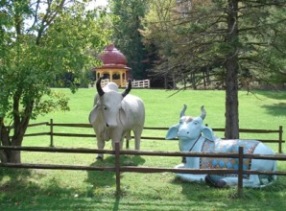
Welcome to Brijabasi Spirit
Thank you for taking the time to visit the New Vrindaban community blog. Think of visiting our blog as making a virtual pilgrimage.
Hare Krishna Hare KrishnaKrishna Krishna Hare Hare
Hare Rama Hare Rama
Rama Rama Hare Hare
"May cows stay in front of me; may cows stay behind me; may cows stay on both sides of me. May I always reside in the midst of cows."
Hari Bhakti-vilas 16.252



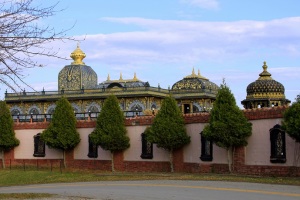
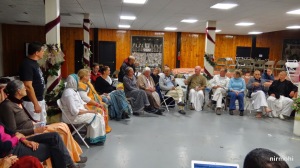
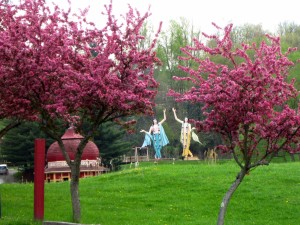

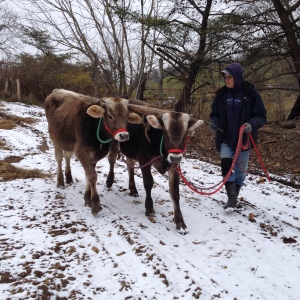
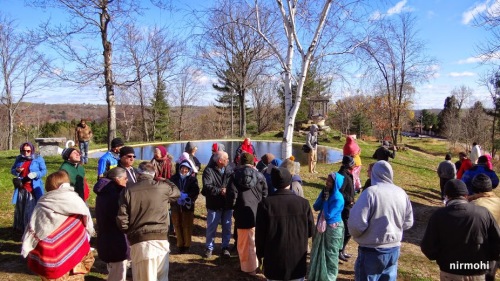
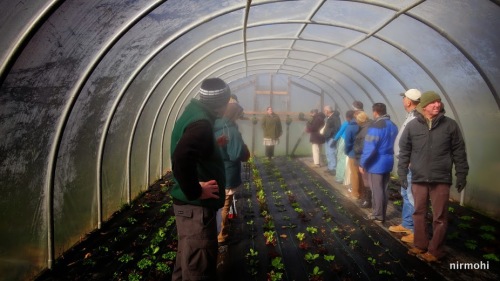
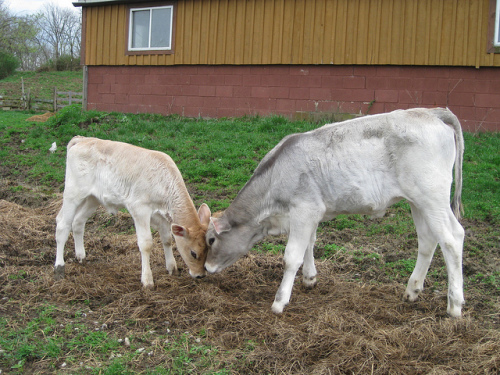

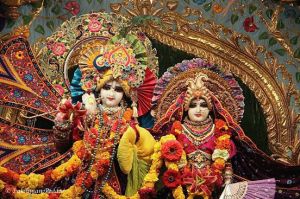



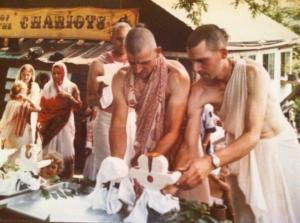
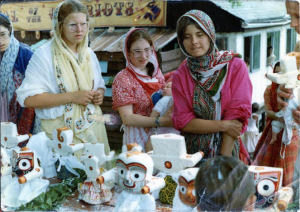

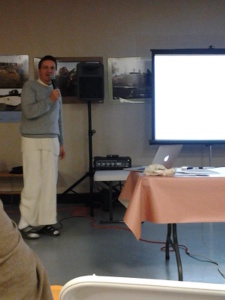
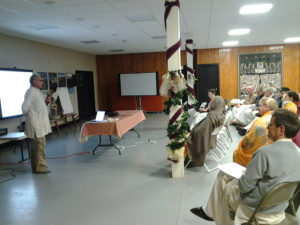
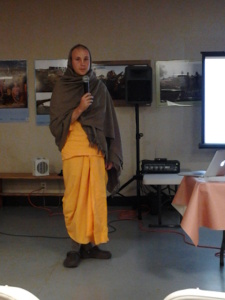
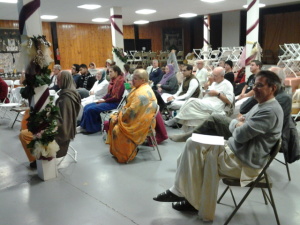
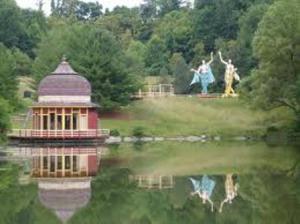




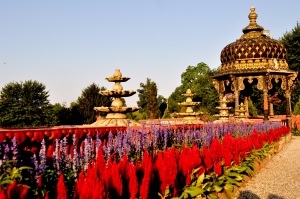
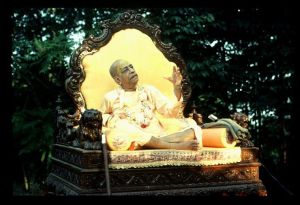
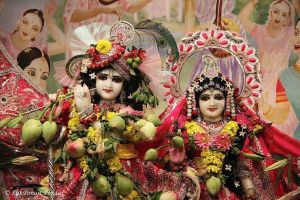
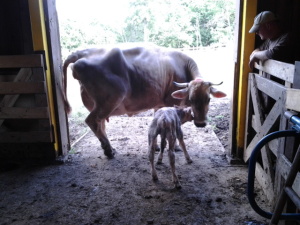
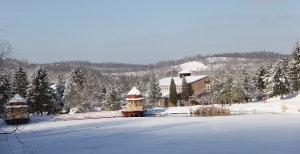




Recent Comments